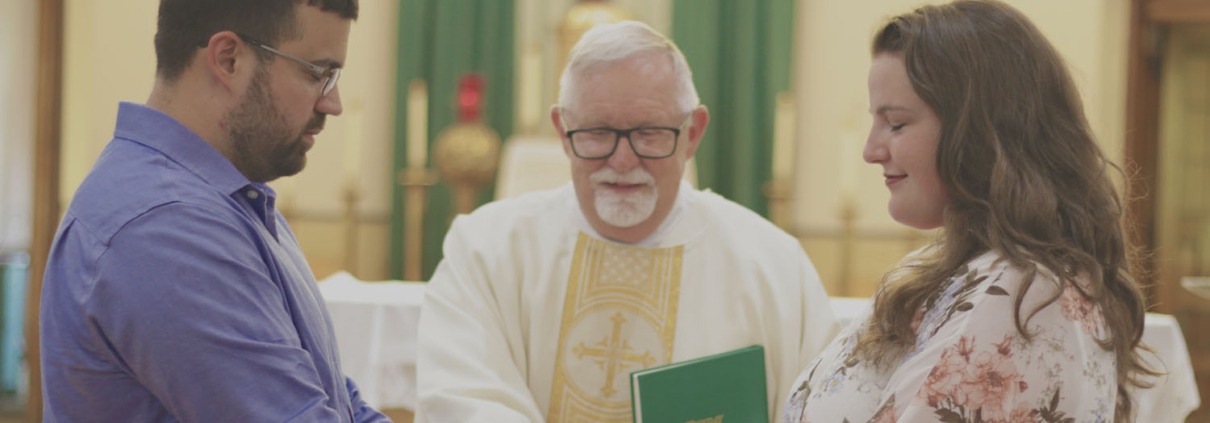Convalidation
“Of course we will do a Catholic marriage service. Do you want to do a Latin Mass?”
This was the first sentence from my Protestant fiancé as we sat down to figure out what our marriage ceremony would look like.
Branden and I had spent the last two days of our fresh engagement basking in the joy of this new chapter and calling our dear ones to share the good news. When we came down from the high of being newly engaged, we sat down to make a game plan for the actual wedding day.
Making Plans for the Wedding
We had secured the date December 5th (but not the 4th because that was already Jay-Z’s birthday), and we knew who we wanted to stand up with us. When I asked Branden what type of ceremony he would want, he surprised me by stating we would have our ceremony within the Catholic Church and even asked about a Latin Mass.
Read more about celebrating the Rite of Marriage here.
I felt so honored and supported, and it was really a significant moment for me in our relationship.
Branden was (and is) a Lutheran pastor. He not only serves a local church, but he is also incredibly involved in many parts of his synod (the Lutheran version of our Catholic diocese).
For him to be fully on board with a Catholic service was a big deal!
While I desired to be married in the Catholic Church, I could see the sacrifices he would be making as an ordained member of his church. Also, nearly all of my dear Catholic friends, colleagues, and connections were over 700 miles away in Minnesota.
Making Choices for Now and Later
After considering both of our strong ties to our churches and that our family and friends were miles apart, we came up with three options:
- We could fly to Minnesota and have our ceremony there and do marriage prep online, but then our elderly relatives from Michigan could not attend.
- We could have a Lutheran ceremony now to honor the connections to his church and be married in a more intimate Catholic ceremony later, but who would be invited to both?
- We could throw our plans to the wind and elope, but we were both pretty sure none of our relatives would support this choice, and we didn’t want to face their wrath after our big day.
We ultimately decided on option #2, and on a beautiful December day, we packed a local Lutheran church with our friends and family while we said our handwritten vows to one another. It was a joyful and prayerful time.
The day was incredibly lovely, and we were so thrilled to be surrounded by this melting pot of people who showered us in love and support.
While that ceremony was a treasured time in our relationship, I was eager to move forward with our marriage in the Catholic Church.
However, we had spent all our planning energy making sure everything was in order for our Lutheran ceremony, and we had no capacity to plan anything else because wedding planning is just A LOT! Time slipped away from us as we transitioned from engaged to married (which is also A LOT), and planning our Catholic ceremony was placed on the back burner for the next 9 months.
Preparing for Convalidation
In August of that year, I began working as a youth minister at a local Catholic parish. Through various conversations, it came up organically that I wasn’t married in the Catholic Church, and a co-worker lovingly approached me and asked, “Would you prayerfully consider having your marriage convalidated?”
Having an external force bring up my (now buried) desire was exactly what I needed to start planning again.
I brought it up to Branden (who still hadn’t fully recovered from wedding planning), and the idea of planning a second wedding seemed insurmountable to him. I reassured him that this would be a more intimate affair and that the real significance was having our marriage valid in the eyes of my church, the universal Church.
Convalidation is when a civil marriage becomes licit under the Code of Canon law of the Catholic Church.
It’s what brings the sacramental graces into the marriage and fully brings it under the authority of Jesus Christ. These were all factors I knew I wanted and needed for our marriage.
Branden and I both agreed that a healthy marriage needed to be under God’s grace to thrive. However, this was challenging for my Protestant husband.
Why was his church not “valid enough”? I explained it wasn’t a matter of “good enough”, but that these were the instructions of the Catholic Church, a church to which I belonged, and wanted to honor as the church instituted by Christ (this led to a fascinating debate about Luther, Constantine, St. Peter, and various translations of the word “rock”).
Ultimately, we decided to move forward, and we picked a date in May for our marriage to be convalidated.
Experiencing Convalidation
To prepare fully for convalidation, we met several times with our deacon and went through some questions together. We also took the online course Living Our Faith in Love through The Marriage Group. Although we had gone through something similar with the Lutheran church, we felt ourselves encountering new material and addressing some topics with greater depth.
Once the education portion was complete, we had to track down the certificates we received after baptism and confirmation, along with our civil marriage certificate, verifying that neither of us had been previously married. These certificates were inspected by our deacon and then sent to the canon lawyer for our diocese. It took about 4 weeks to have our paperwork processed and approved. Once we got that approval, we were good to go!
On May 27th, we had 8 people gather around us as we met in an Eucharistic chapel with stunning stained glass. Our daughters got to be flower girls again which was the absolute highlight of their day. We read through scripture, our deacon gave a moving homily, and we said our traditional vows as the deacon directed us. Our rings were blessed, and we sealed our marriage with a kiss!
When compared to our Lutheran ceremony, the Catholic wedding was peacefully reverent. While it happened with much less fanfare, I felt the same amount of joy. Being connected and celebrated in the Church brought a fullness to our marriage. Both of our faith traditions were honored, and I got to wear TWO wedding dresses. All in all, we agree that it was a very good decision to have our marriage convalidated.



